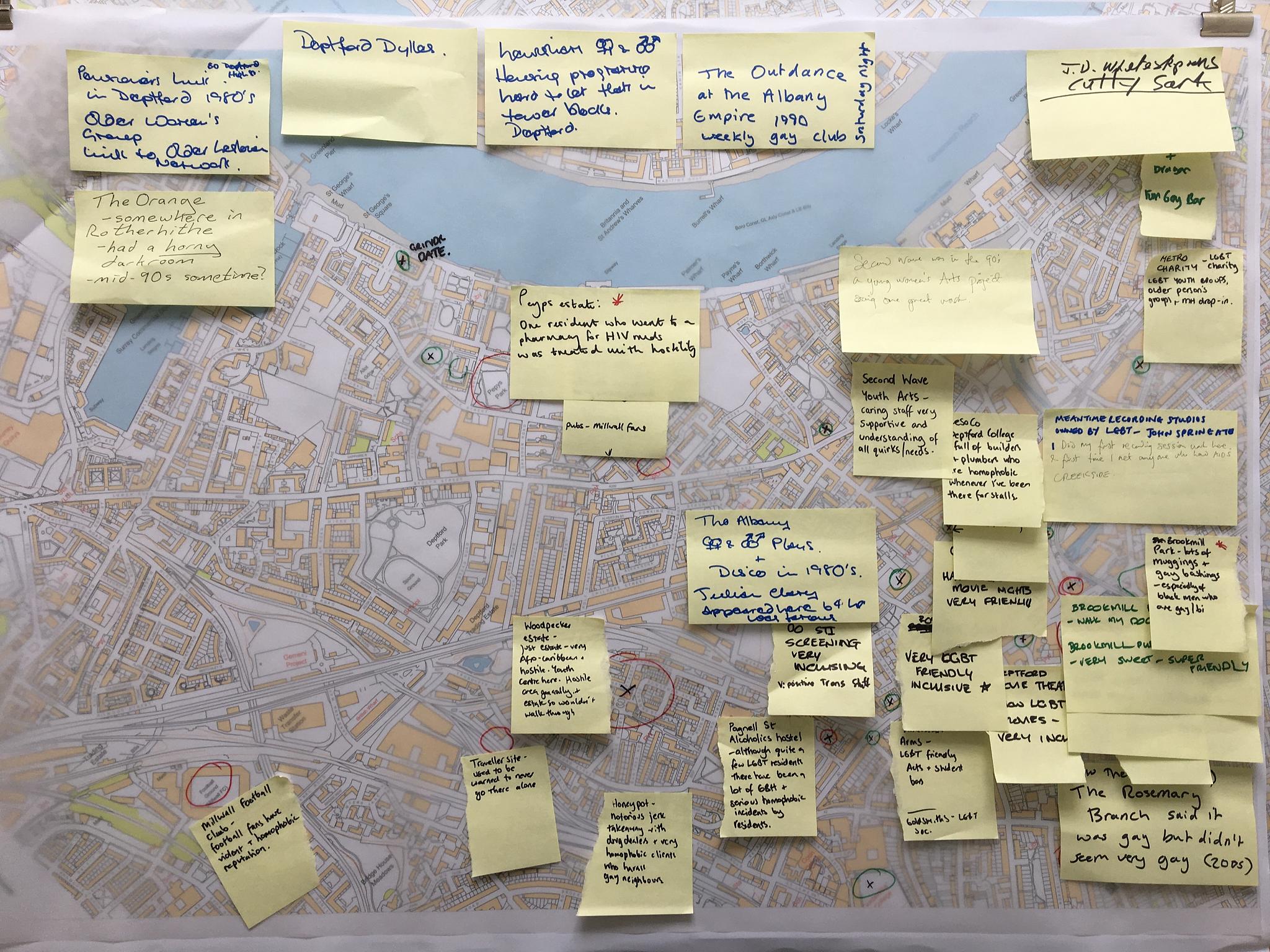Social mapping of LGBT+ spaces in Deptford
This is a social mapping project about the LGBT+ community in Deptford in collaboration with Goldsmiths, University of London’s Centre for Community Engagement Research.
Primary page content
Important terms
- LGBT+ refers to people who identify as lesbian, gay, bi-sexual or transgender
- The plus (+) is an umbrella term intended to be inclusive of all minority sexual orientations and gender identities.
- Transgender refers to people whose gender is different from the sex they were assigned at birth.

What is social mapping
American urban planner Kevin Lynch saw social mapping as a way for people to create a visual representation of their community and to document their personal experiences within it. During the project, I asked 22 participants to draw, highlight and annotate the areas of the map they considered to be LGBT+ safe/unsafe spaces in Deptford and explain why. This varied from libraries and theatres to local parks and housing estates. What started as a safe space project became a more general documentation of LGBT+ experiences and history in the area.
The reason I chose to focus on Deptford is because very little information exists on the LGBT+ community there, despite its rich history of gay culture in the 1980s and 90s. Deptford is also important because in the last few decades it has been the subject of large-scale development which has sparked several local anti-gentrification movements. Throughout the project it became evident that gentrification affected the LGBT+ community in radically different ways, varying across people’s income, ethnicity and abilities. For example, 4 out of the 10 participants who were not students earned less than £10,000 a year whilst 2 earned over £70,000. It is, therefore, important to recognise the vast differences within the community and not to consider them as one homogenous group.
There are many residents who have spent their whole lives living in Deptford; many of whom depend upon social housing. In contrast, there has been a recent influx of younger people, with higher incomes, moving into the area’s expensive new developments. For example, 6 of the 22 participants disclosed that they live in social housing in Deptford, whilst 2 live in the newly developed apartment blocks. The effects of gentrification – such as new cafes, bars and apartments - can give the impression that the area is more LGBT+ friendly and accessible. This is because it tends to attract a younger, wealthier crowd. In reality, however, this can out-price and push out LGBT+ people who do not fit into this narrow demographic.
One of the purposes of this project is to deconstruct the myth that gentrification, or ‘gayification’ as it has been referred to, serves to benefit all members of the LGBT+ community. People with different socioeconomic backgrounds, ethnicities, gender, abilities and sexualities can be affected in radically different ways. Thus, the map must be understood in this respect: one person’s safety is not another's. This project, nevertheless, remains a valuable source of information about personal LGBT+ experiences in Deptford.
Since very few LGBT+ groups exist in Deptford today, I had to look further afield to Greenwich and Lewisham as a whole to carry out research. The main groups that I approached for this project were Lewisham LGBT forum, the mental health and wellbeing service METRO in Greenwich and Goldsmiths University students. I was also in contact with local Labour councillors who expressed their interest in representing the LGBT+ community more.
The aim of the project was to aggregate and map individual experiences in Deptford. Social mapping is an accessible way to visually represent a community. However, there are a few points I would like to make about my findings:
- Many participants who did not live in Deptford had a preconceived impression of the area, being that it was largely unsafe and unfriendly to LGBT+ people. Moreover, some participants expressed racial and class based prejudices; there was the harmful assumption that the low-income and large black community would be hostile towards LGBT+ people.
- Contrary to this, many participants who lived and grew up in Deptford had a different outlook. In many respects, their outlook was far more positive. For example, participants over 45 recalled the vibrant music scene of the 1980s and 90s, which attracted a whole range of people from different ethnicities and backgrounds: including an LGBT+ crowd.
- Considering Deptford has many BAME (Black, Asian and minority ethnic) communities, it is important to recognise that my project is not fully representative of this demographic. 19 out of 22 participants were white. The two main LGBT+ organisations in the Deptford area are the Lewisham LGBT Forum and METRO Greenwich; neither of which are based in Deptford itself. These were the only organisations I had contact with, that were exclusively LGBT, and both of these groups were predominantly white. Accordingly, the three BAME participants I spoke to were separate from both of these organisations.
This information is important for Deptford’s LGBT+ community as it provides a valuable insight into individual experiences. I hope this information will be used and expanded further to produce a more substantial body of work. I would like to thank the 22 participants who took part in this collaborative project and opened up to me about their personal experiences. I hope you find the map useful.
Please contact me if you would like to add your own experience/comments to the map. All contributions are anonymous.
Email - mappinglgbtdeptford@gmail.com
Recommended sources:
- Destination Deptford documentary
- Pepys Community Forum / Voice for Deptford
- LGBT Lewisham Blog (search for Facebook page to contact them)
- METRO Charity